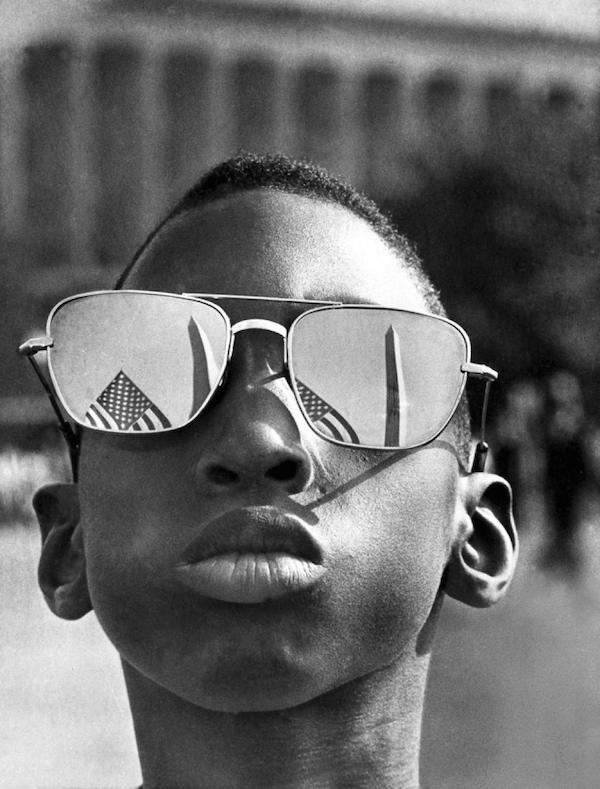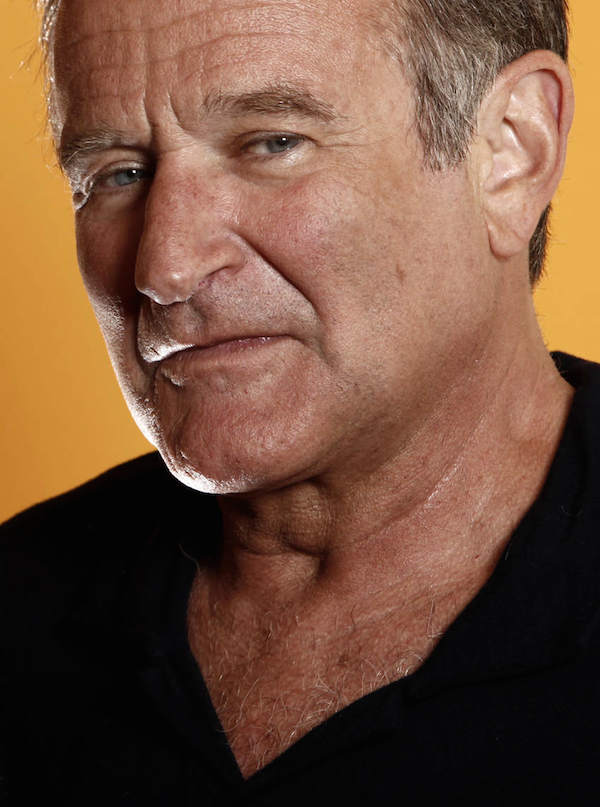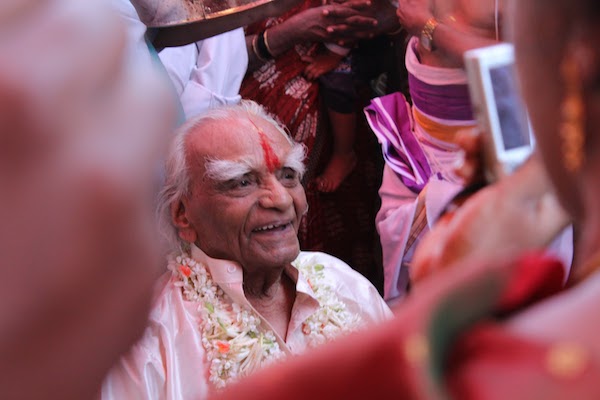Three Deaths in August: Michael Brown, Robin Williams & BKS Iyengar
“Each and every day on our planet, 154,957 of us, give or take, die (a number derived from data gleaned between 2012 and 2014 by the CIA, the World Bank, the UN World Population Study, and the US Census). On August 9, at the age of 18, one of us died of bullet wounds in Ferguson, Missouri. On August 11, a suicide at age 63, one of us died at his home in Paradise Cay, California. On August 20, at 95, yet another of us died of heart failure at a Pune, India hospital. Three men. Three lives. Three ways of life and death so radically different, one from the other, as to belie the fact that all three individuals were members of the same species.”—By Elizabeth Boleman-Herring
Ruminant With A View
By Elizabeth Boleman-Herring
“When he shall die,/Take him and cut him out in little stars,/And he will make the face of heaven so fine/That all the world will be in love with night/And pay no worship to the garish sun.”—William Shakespeare, from “Romeo and Juliet”
“We die containing a richness of lovers and tribes, tastes we have swallowed, bodies we have plunged into and swum up as if rivers of wisdom, characters we have climbed into as if trees, fears we have hidden in as if caves. I wish for all this to be marked on my body when I am dead. I believe in such cartography—to be marked by nature, not just to label ourselves on a map like the names of rich men and women on buildings. We are communal histories, communal books. We are not owned or monogamous in our taste or experience.”—Michael Ondaatje, from The English Patient

 BRIDGE & TUNNEL New Jersey—(Weekly Hubris)—8/25/2014—Each and every day on our planet, 154,957 of us, give or take, die (a number derived from data gleaned between 2012 and 2014 by the CIA, the World Bank, the UN World Population Study, and the US Census).
BRIDGE & TUNNEL New Jersey—(Weekly Hubris)—8/25/2014—Each and every day on our planet, 154,957 of us, give or take, die (a number derived from data gleaned between 2012 and 2014 by the CIA, the World Bank, the UN World Population Study, and the US Census).
On August 9, at the age of 18, one of us died of bullet wounds in Ferguson, Missouri.
On August 11, a suicide at age 63, one of us died at his home in Paradise Cay, California.
On August 20, at 95, yet another of us died of heart failure at a Pune, India hospital.
Three men. Three lives. Three ways of life and death so radically different, one from the other, as to belie the fact that all three individuals were members of the same species.
Oh, but they were. Our species.
One was an all-but-anonymous, because so young, American teenager and high school graduate about to enter trade school. One was a world-famous, award-winning comedian, the likes of whom will never tread the boards again. One was a master of Yoga, considered a guru by (perhaps) millions of devotees.
Michael Brown. Robin Williams. BKS Iyengar. Three men gone within the span of 12 days in August. Three out of 154,957.
Gone and mourned.
If you Google “Michael Brown Ferguson Missouri,” you will find (give or take) some 59,800,600 entries, but very, very few of these will tell you anything of substance about the 18-year-old shot to death on August 9.
What is there to have said about most 18-year-olds?
Most teenagers have lived just the bare, still-not-fully-formed bones of a life, and leave no paper trail at all. There has been some reporting, notably “11 Things You Should Know About Michael Brown,” from Vox.com, but only Brown’s immediate family and friends will perhaps ever tell us what Brown was like. Who he might have become.
As a member of one of this nation’s most “at risk” underclasses*—teenaged African-American “men”—Michael Brown couldn’t afford a misstep, even a tiny one, without appearing on the radar of the (usually white) powers that be. We have images of Brown on video roughing up the (also underclass) clerk in a Ferguson convenience store, allegedly in the course of robbing the shop of cigars, but we have, as yet, no real notion of what, if anything, he may have done, later the same day, to so enrage a Missouri police officer that the man fired six bullets into an unarmed teenager.
If I were Michael Brown’s grandmother, I would be lying on the floor screaming. I would be screaming, for the most part, because I know (as does she) that Brown had just so few chances to escape his particular fate. He was at risk in America, because of his race, because of his gender, because of his socio-economic status, from the day he drew breath.
OK, yes, I also spent this past week watching Mo’ne Davis and Eric Holder and Curtis Granderson (among many other American celebrities of color), African-Americans who have, seemingly, at different points in life and in different American communities, “escaped the straits of doom” through which so many members of their greater community travel, ending in poverty, imprisonment, and worse.
But we all know the scales are (still) rigged from birth, here in America. Step out of line, simply be in the wrong place at the wrong time, just be born Black . . . and 18 years may be all you have in The Land of Opportunity.
Six bullets or a rope: has anything changed much since the murder of Emmett Till?
Not to my mind. No, not one iota. Michael Brown was, I believe—and the facts will prove me on or off base here, if ever we can determine them—shot dead for “being uppity.”
Don’t the Missouri cops know all 18-year-olds are uppity? It’s what being 18 is about, pushing envelopes. And, if you’re really lucky, it’s your grandmother, and not Darren Wilson who’s there when you decide to “be 18,” even if it’s something as benign as walking down the middle of the street.
I can tell you, if Michael Brown had just made his way home, safely, on August 9, and then been arrested for stealing $48.99 worth of cigars, his mother and grandmother would have got him back on the straight and narrow. Which is what relatives, and friends, and community elders try to do for all 18-year-olds.
All boys, for the most part, unless they’re planning to run on a Republican Party ticket, do get into trouble at some point en route to becoming men. And it’s our job as family, clergy, friends, and officers of the law to prod boys in more productive directions, not gun them down, unarmed, in the middle of streets.
So, on August 9, at the age of 18, one of us died of bullet wounds in Ferguson, Missouri.

And then, on August 11 came the death of Robin Williams by suicide, and a torrent of verbiage poured forth in the popular press which shared a theme common to much of the coverage of Michael Brown’s death. Wasn’t there some way, people hemmed and hawed, to blame this victim (of debilitating, lifelong mental illness) for his own death? To blame him, not for being in the wrong place at the right time, for being Black but, almost as insidiously, for not being up to the task of remaining conscious a moment longer while the demons of depression consumed him; the certainty of his end (in depression, with Parkinson’s) came home to him.
To Williams, it must all have looked downhill from 63.
I know it does to me, as I also battle depression, and the monstrous side effects—so many of them permanent—of the psychotropic drugs (“medications” is much too saccharine a term) prescribed for me (and for Williams), for decades, by well-meaning if completely ignorant Western physicians.
We don’t know enough about Williams’s stable of inter-cranial foes to say what pushed him over the edge. Perhaps he had been over an edge for a very, very long time. It is not at all easy to hang oneself. It takes quite some grit. So perhaps—and this is what I believe—he had just finally taken so much that one more instant of consciousness was more than he could bear.
But still, throughout the blogosphere, on the air waves, people who have never known depression vilified him. People expressed their anger at him “for his family’s sake.”
As I have often remarked before, we are a failed species.
But ah, yes, failed as we are, Robin Williams was one of us. Throughout his career on the stage, before a camera, or simply behind (all over!) a microphone, as he was in “Aladdin,” he was the Nijinsky of comedy. Like a Labrador puppy—dogs never lie with their tails—he had wit coursing through his body and soul, and it spilled out for us, over and over and over, in all the films, and film clips, and out-takes I’ve been re-watching this past week.
Goooood MORRRRNING, Viet Nam!!!!!!!
I will not simply “miss” this man. When he left us, when he left me—I take it that personally—a certain laugh of which I was once capable, while he lived, also left me.
Yes, I can watch and re-watch his great body of work . . . but there will never again be anything new. As I no longer look forward to whatever George Carlin might come up with, I can now no longer look forward to Robin Williams’s next outing.
But I am not one tiny bit angry at him, on my own behalf nor on behalf of those who loved him up-close: he was “shot down in the street ,” felled in the midst of life, as surely as was Michael Brown. Every single day, living with depression, I wake up and wonder, “Is this the day when the pain will be just a little too great?”
So, though Williams was not marginalized by his color, his poverty, his gender, or his status, I do see him as Michael Brown’s “fellow underclassmen.” Because, in the US, depression is still not something one discusses in the parlor, not something the medical establishment has made any significant steps towards curing (at least over the course of my lifetime and Williams’s, and we were born in the same year), and not something for which the general hail-fellow-well-met public has much sympathy, let alone empathy.
I am simply and utterly grateful Robin Williams, dead by his own agile and articulate hand, on August 11, stayed among us as long as he did.

BKS Iyengar, who died on August 20, at the age of 95, in the northern Indian city made famous by his genre of Yoga, has been my guru-at-a-far-remove for the past 15 years. (“The syllable ‘gu’ means shadows. The syllable ‘ru,’ he who disperses them. Because of the power to disperse darkness the guru is thus named.” Advayataraka Upanishad 14—18, verse 5.)
I am but one among millions who have found “Guruji,” and the entire gestalt of asana and pranayama that he did not “invent” but, rather, into which he breathed his own life, an inspiration.
There was, for me, first Yoga; then, Iyengar Yoga . . . a sort of course of miracles in its own right.
Bellur Krishnamachar Sundararaja Iyengar was born on 14 December 1918 and so, by the time he breathed his last in Pune, he had lived a long and remarkable life, if anything but an easy one.
Born in the midst of an influenza pandemic, the eleventh of 13 children, he weathered malaria, tuberculosis, typhoid, and starvation in his early years. When he was five, his father died of appendicitis. At 15, apprenticed to his brother-in-law, the renowned if fierce Yogi Sri Tirumalai Krishnamacharya, Iyengar began an arduous journey into physical Yoga (asana), Yogic breathing (pranayama), and spiritual practice.
Credited, when he was in his mid-30s, with being the first to bring Yoga to a mass Western audience, Iyengar went on to create a vast teaching and certification apparatus, and to write further books in his “Light on . . .” series, all of which, as a whole, comprise a sort of “bible of Yoga,” though Iyengar himself believed that the living teaching, not what was on any page, is what truly matters in the discipline.
It is an odd thing to have studied a man’s work as deeply and as constantly as I have studied Iyengar’s and, yet, to admit that I could never, can never now, “know” the man at all.
Like Balanchine, the man was his message, in the flesh and, finally, one truly needed to “be” with him to take on board the full curriculum.
All of us out here who practice (and practice) Iyengar Yoga are like a vast corps de ballet; some of us better, some of us abysmal, avatars of his technique and knowledge. But oh, we knew what we were witnessing when we watched him or read him. He was an embodied master.
I have followed his teachings “on the mat” to the exclusion of most other teachers, and I have even embodied some of his “method” as a teacher (back when I was teaching Yoga). But I always felt I had lit my small candle at some vast furnace of incandescence with Iyengar: I was very happy he had shared his light and warmth and fuel, but I was (also) glad never to have come any closer.
We all knew, in the Yoga community, that this man who had practiced some three hours a day into his early 90s could not live forever. We knew his death was imminent. But we all, also, sort of thought that if anyone could avoid mortality, it would be this man.
Instead, quietly, he joined the ranks of the 154,957 on August 20.
All three men have joined those ranks now, Michael Brown, Robin Williams, and BKS Iyengar, leaving those of us whose lives they touched—in person, at a distance, through the muddy aether of cyberspace, or over decades of study—reeling for the time being.
As writer Anne Lamott says: “You will lose someone you can’t live without, and your heart will be badly broken, and the bad news is that you never completely get over the loss of your beloved. But this is also the good news. They live forever in your broken heart that doesn’t seal back up. And you come through. It’s like having a broken leg that never heals perfectly—that still hurts when the weather gets cold, but you learn to dance with the limp.”
You learn to dance . . . with the limp.

*. . . and our nation currently has so many “underclassmen,” including children; all African-American young people; the elderly uninsured unable to live on their Social Security premiums (who have morphed into a new wave of underpaid, seasonal migrant laborers); all women not paid the same wage as men for the same work; the homeless; the untreated mentally ill; “illegals,” etc. etc., etc.

Note: Photo 1, an AP photograph dating from the March on Washington, derives from http://www.historybyzim.com/2014/06/march-on-washington-through-sunglasses-1963/; Photo 2 derives from http://napervillesun.suntimes.com/2014/08/15/hollywood-palms-robin-williams-film-tribute/; and Photo 3 derives from http://wondersofyog.blogspot.com/2012/12/guruji-bks-iyengars-94th-birthday.html.
Further: If you’ve not seen or read the following, please follow these links: David Letterman on Williams: http://www.cinemablend.com/television/Watch-David-Letterman-Touching-Tribute-Robin-Williams-66822.html; The New York Times breaks the news of Iyengar’s death: http://www.nytimes.com/2014/08/21/world/asia/bks-iyengar-who-helped-bring-yoga-to-west-dies-at-95.html?_r=0.


8 Comments
Rick Boling
Excellent essay, Elizabeth. Fortunately (or not) I continue to limp along, though the insults multiply with the years, making that limp ever more pronounced.
Elizabeth Boleman-Herring
Thank you, Rick. But you dance, in so, so many ways, despite and because of that limp. Love, Elizabeth
Alan Ichiyasu
The best yet, #1…no joke!
Thank you.
Anita Sullivan
Thank you for this, Elizabeth, it’s beautiful. That’s all I am able to say.
Elizabeth Boleman-Herring
Anita, I fear I’ve finally become Eeyore, when I’d so hoped to remain Christopher Robin, but I thank you. To know that “you read me” is a great gift. xoxoxoxo
Elizabeth Boleman-Herring
Alan, Samurai, we limp on . . . together, Old Friend! :-)
diana
Written from the heart but using your incomparable soul and mind, this really moved me but you do not convince me that we are a failed species, not with people like Williams, Iyengar and you around. With love from Gimpy.
Elizabeth Boleman-Herring
Thank you, always, Diana. And I’m gimpy, too, as you well know–just emotionally gimpy. xoxoxoxo